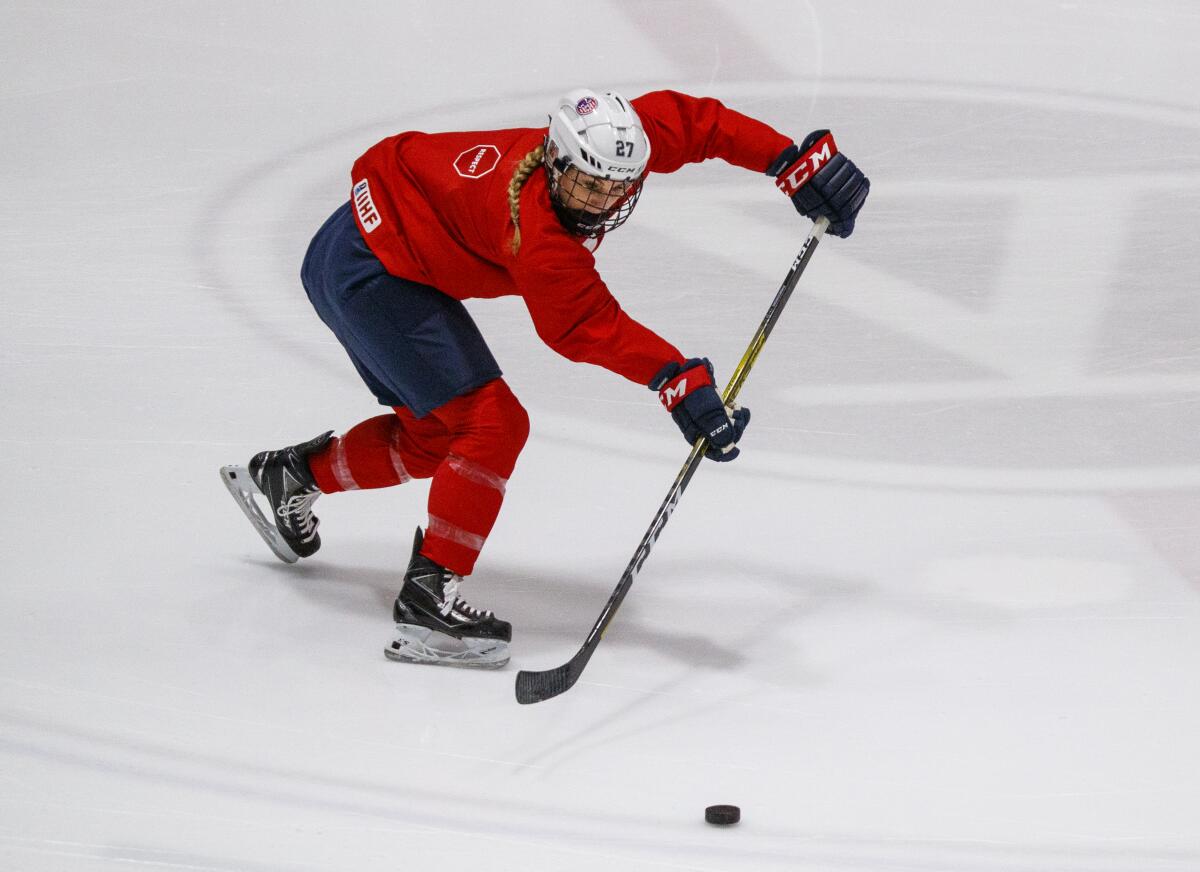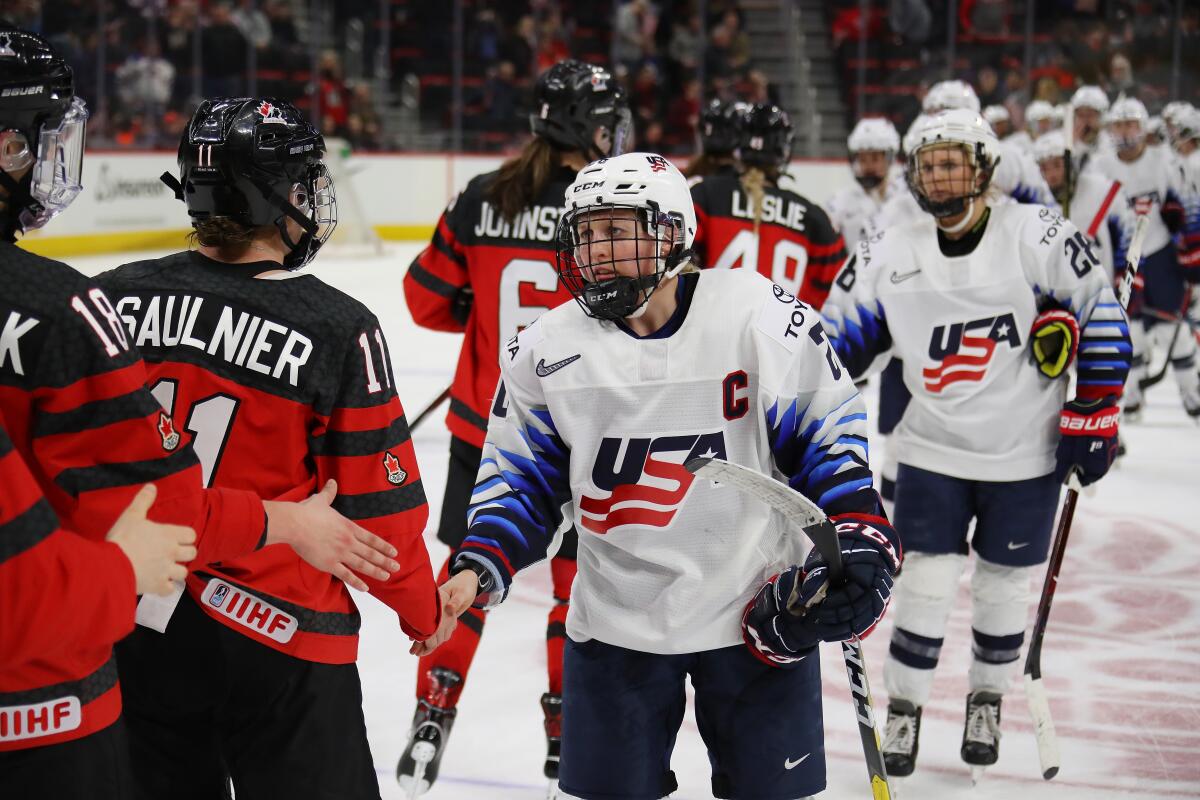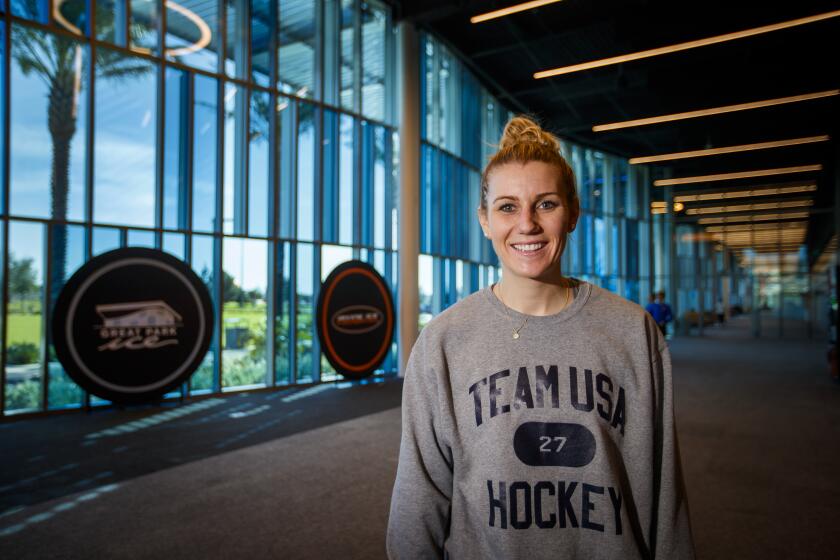For U.S. women’s hockey team, promoting the game is never-ending job

- Share via
Playing for the U.S. women’s national hockey team requires discipline, skill, and the zeal to be a crusader for a sport that most fans notice only during the Winter Olympics, if they pay attention at all.
The speed, sureness and ever-rising level of play make women’s hockey thoroughly entertaining, but those advances haven’t been enough to attract the financial investments and audiences needed to launch a viable professional league. So in addition to playing the game, they’re selling it — making impressions and winning fans with every picture they take, every autograph they scribble, and every word of encouragement they whisper to the kids they encounter.
Their efforts have put them in position to enjoy an important moment Saturday, when USA will face Canada at Honda Center in the finale of their five-game Rivalry Series and the first game for the U.S. women’s team in Southern California. More than 12,000 tickets had been sold by Friday morning, promising a record for a U.S. women’s national hockey team contest in the United States. It will be aired on the NHL Network starting at 7 p.m.
The U.S. women clinched ownership of the Rivalry Series championship trophy by winning three of the first four games, but their long and competitive history against Canada ensures a lively game Saturday. This series — which consisted of only three games last season and should be longer in future years — is probably their most valuable tool to promote hockey besides the Olympics.
But even after they exit the ice Saturday, their efforts to promote hockey will continue. Their work might never be done.
Players will sign autographs after the game and on Sunday will participate in a skills clinic for kids aged 6 to 16 at Great Park Ice in Irvine, where the team trained last week. While in Southern California, they’ve skated with youth teams, spoken to leadership groups and scrimmaged with the Ducks, all to make people aware who they are and what they do so well.
They’re also creating lasting memories.
“I remember being a bug on the glass in 2005 when the women’s national team came through United Center, and they haven’t come back since,” said forward Kendall Coyne Schofield, who grew up near Chicago and now lives in Irvine with husband Michael Schofield, an offensive guard for the Chargers.
“I remember that, and being so amazed at being able to see them, and I think about it today, wow, the opportunity hasn’t come back. So you never know if these girls will get another chance to see us. I think we all take that very seriously knowing there are limited opportunities, but we’re fighting for more and more opportunities so they can see us and they can be us.”
As a mite-level player, forward Annie Pankowski of Laguna Hills skated on the Honda Center ice between periods of a Ducks game. Her family had season tickets. “It’s kind of surreal to come back here and have a big game here,” she said Friday after the team’s practice.
Like her teammates, she has been meeting and greeting kids during the team’s stay. Participating in a session with one of the younger Lady Ducks teams awakened warm memories of her hockey adventures when she was their age.
“The girls were very cute and very excited to be out there, and I got a lot of tweets after from their parents about their smiles and how excited they were,” she said. “And it’s funny because that’s exactly how I felt when I was out there skating for the Ducks. To have that come full circle is really special, and to be a part of that especially in my hometown is amazing.”
Annie Pankowski came close to the making the U.S. women’s hockey team for the last two Olympics. She’s hoping the third time is the charm.
The Rivalry Series was created in the settlement of a 2017 dispute between female players and USA Hockey, the sport’s national governing body. At the women’s insistence, USA Hockey agreed to promote the sport’s growth among women and girls and create more opportunities for the national team to compete. The Rivalry Series has been intriguing but it’s too short, and it should involve cooperation from more NHL teams.
“You’re preaching to the choir,” Coyne Schofield said. “If you ask the players, the more the merrier. We’ll play as many games as they’ll let us.”

This series still doesn’t compensate for the lack of regular competition. Most elite players chose not to play in the National Women’s Hockey League this season because they’re hoping a larger and more financially stable league will be created. As a result, most work out on their own.
“We all love this game so much to not figure it out and grind through this year to leave this game better than we entered it,” Coyne Schofield said. “The time that you get to be together, especially in sunny California, just a little bit more, you really cherish those moments. You get out there, you get to work. You soak in the moments you’re together because more times than not you’re alone and you’re passing to the boards or you’re passing to a little rubber band that’s passing back to you, or you have a skills coach here. ... We’re trying to create that situation more routinely and not just from a national team level but from a professional level.”
Until then, they’ll enjoy moments like Saturday night, when they’ll play in front of a lively, shrieking crowd.
“We don’t stop. The press might stop, the media might stop, the lights might turn off, but ours don’t. We’re going every single day,” Coyne Schofield said. “This team is so committed. [ Canada] is so committed. We’re fighting for the same goal, and people might not see what we do day in and day out, but we’re working just as hard as the guys you see when you turn on the TV at night and have a full building of 19,000 people. We’re putting in the same work. We don’t have the exact spotlight yet, but we’re working for it.”
More to Read
Go beyond the scoreboard
Get the latest on L.A.'s teams in the daily Sports Report newsletter.
You may occasionally receive promotional content from the Los Angeles Times.








